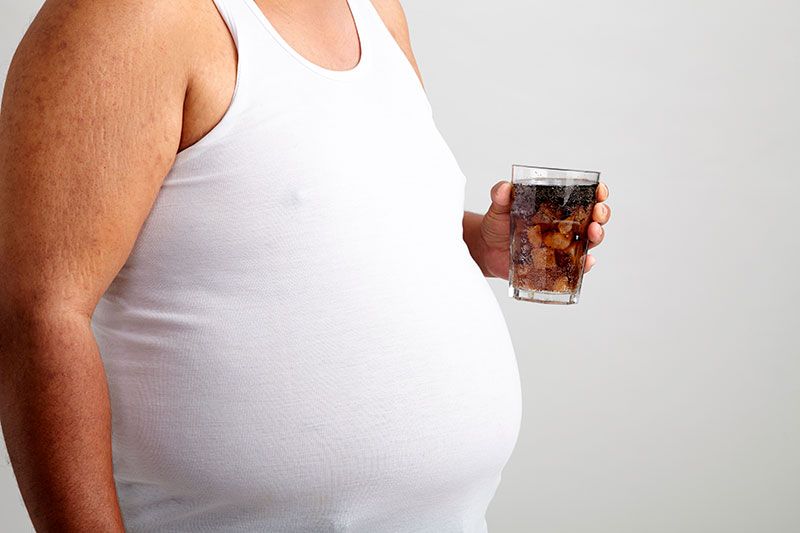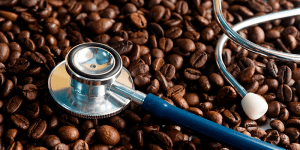Bebidas con cafeína y sin cafeína y riesgo de diabetes tipo 2
28-04-2017
Evaluar la asociación entre consumo de bebidas cafeínadas y bebidas no cafeinadas, que incluyen café, té, bebidas endulzadas (SSB) y bebidas carbonatadas artificialmente endulzadas (ASBs), con el riesgo de diabetes mellitus tipo 2. Metodología: Estudio prospectivo de cohortes que incluyó 74,749 mujeres (30-55 años) y 39,059 hombres (40-75 años), todos profesionales de la salud en Estados Unidos (NHS y HPFS, respectivamente). En ambas cohortes, se siguió a los sujetos bianualmente mediante cuestionarios estandarizados que informaban sobre su historia médica, estilos de vida y ocurrencia de enfermedades crónicas. Se usaron modelos de regresión COX para el análisis para examinar la asociación entre bebidas cafeínadas y descafeínadas y el riesgo de diabetes mellitus tipo 2 además de análisis multivariados. Resultados: En la cohorte HPFS, el consumo de café con cafeína se asoció a una disminución del 4% (RR: 0.96; 95% CI: 0.93, 0.98) y el consumo de café descafeínado a una disminución del 7% (RR: 0.93; 95% CI: 0.89, 0.97) de riesgo para DM2. En la cohorte NHS, no hubo diferencia en la magnitud de la asociación entre la café con cafeína (RR por cada incremento de 1 taza: 0.92, IC 95%: 0,91 a 0,94) y café descafeinado (RR por cada incremento de 1 taza: 0.92, IC 95% : 0.90, 0.95) y el riesgo de diabetes tipo 2. Al controlar por factores dietarios y estilo de vida, el consumo de bebidas cafeínadas y bebidas descafeínadas endulzadas estuvo significativamente asociado a un mayor riesgo de DM tipo 2 en el NHS (RR por porción: 13% para SSBs cafeína, el 11% de SSBs sin cafeína , p <0,05) y en el HPFS (RR por porción: 16% de SSB con cafeína, 23% de SSB libres de cafeína, P<0,01). El consumo de té con cafeína se asoció inversamente con el riesgo de diabetes tipo 2 en mujeres (RR por cada incremento de 1 taza: 0.95, IC 95%: 0,92 a 0,97), pero no en hombres (RR por cada incremento de 1 taza: 0.99, IC 95%: 0.94, 1.04). Conclusiones: Independiente del contenido de cafeína, el consumo de SSB se asoció con un mayor riesgo de diabetes tipo 2 y el consumo de café se asoció con un menor riesgo de diabetes tipo 2. Los autores sugieren que la asociación entre un mayor consumo de SSB y un mayor riesgo de diabetes tipo 2 es potencialmente un resultado del alto contenido de sacarosa o jarabe de maíz de alta fructosa en estas bebidas y no a un efecto conjunto de la cafeína y el azúcar.
Bhupathiraju SN, Pan A, Malik VS, Manson JE, Willett WC, van Dam RM, Hu FB. Caffeinated and caffeine-free beverages and risk of type 2 diabetes. Am J Clin Nutr. 2013 Jan;97(1):155-66.
[1] CDC: National diabetes fact sheet; 2007. In.
[2] van Dam RM. Coffee consumption and risk of type 2 diabetes, cardiovascular diseases, and cancer. Appl Physiol Nutr Metab 2008;33:1269e83.
[3] Sofi F, Conti AA, Gori AM, Eliana Luisi ML, Casini A, Abbate R, et al. Coffee consumption and risk of coronary heart disease: a meta-analysis. Nutr Metab Cardiovasc Dis 2007;17:209e23.
[4] Tuomilehto J, Hu G, Bidel S, Lindstrom J, Jousilahti P. Coffee consumption and risk of type 2 diabetes mellitus among middle-aged Finnish men and women. JAMA 2004;291:1213e9.
[5] Salazar-Martinez E, Willett WC, Ascherio A, Manson JE, Leitzmann MF, Stampfer MJ, et al. Coffee consumption and risk for type 2 diabetes mellitus. Ann Intern Med 2004;140: 1e8.
[6] van Dam RM, Feskens EJ. Coffee consumption and risk of type 2 diabetes mellitus. Lancet 2002;360:1477e8.[7] Rosengren A, Dotevall A, Wilhelmsen L, Thelle D, Johansson S. Coffee and incidence of diabetes in Swedish women: a prospective 18-year follow-up study. J Intern Med 2004;255: 89e95.
[8] van Dam RM, Willett WC, Manson JE, Hu FB. Coffee, caffeine, and risk of type 2 diabetes: a prospective cohort study in younger and middle-aged U.S. women. Diabetes Care 2006;29: 398e403.
[9] Carlsson S, Hammar N, Grill V, Kaprio J. Coffee consumption and risk of type 2 diabetes in finnish twins. Int J Epidemiol 2004;33:616e7.
[10] Smith B, Wingard DL, Smith TC, Kritz-Silverstein D, Barrett- Connor E. Does coffee consumption reduce the risk of type 2 diabetes in individuals with impaired glucose? Diabetes Care 2006;29:2385e90.
[11] Pereira MA, Parker ED, Folsom AR. Coffee consumption and risk of type 2 diabetes mellitus: an 11-year prospective study of 28 812 postmenopausal women. Arch Intern Med 2006;166: 1311e6.
[12] Paynter NP, Yeh HC, Voutilainen S, Schmidt MI, Heiss G, Folsom AR, et al. Coffee and sweetened beverage consumption and the risk of type 2 diabetes mellitus: the atherosclerosis risk in communities study. Am J Epidemiol 2006;164: 1075e84.
[13] van Dam RM, Hu FB. Coffee consumption and risk of type 2 diabetes: a systematic review. JAMA 2005;294:97e104.
[14] Lee ET, Welty TK, Cowan LD, Wang W, Rhoades DA, Devereux R, et al. Incidence of diabetes in American Indians of three geographic areas: the strong heart study. Diabetes Care 2002;25:49e54.
[15] Lee ET, Howard BV, Savage PJ, Cowan LD, Fabsitz RR, Oopik AJ, et al. Diabetes and impaired glucose tolerance in three American Indian populations aged 45-74 years. The strong heart study. Diabetes Care 1995;18:599e610.
[16] Lee ET, Welty TK, Fabsitz R, Cowan LD, Le NA, Oopik AJ, et al. The strong heart study. A study of cardiovascular disease in American Indians: design and methods. Am J Epidemiol 1990; 132:1141e55.
[17] Howard BV, Welty TK, Fabsitz RR, Cowan LD, Oopik AJ, Le NA, et al. Risk factors for coronary heart disease in diabetic and nondiabetic Native Americans. The strong heart study. Diabetes 1992;41(Suppl. 2):4e11.
[18] Cowan LD, Go OT, Howard BV, Devereux RB, Pettitt DJ, Fabsitz RR, et al. Parity, postmenopausal estrogen use, and cardiovascular disease risk factors in American Indian women: the strong heart study. J Women’s Health 1997;6: 441e9.
[19] Alberti KG, Zimmet PZ. Definition, diagnosis and classification of diabetes mellitus and its complications. Part 1: diagnosis and classification of diabetes mellitus provisional report of a WHO consultation. Diabetic Med 1998;15:539e53 [see comment].
[20] Kriska AM, Sandler RB, Cauley JA, LaPorte RE, Hom DL, Pambianco G. The assessment of historical physical activity and its relation to adult bone parameters. Am J Epidemiol 1988;127:1053e63.
[21] Cowan LD, Go OT, Howard BV, Devereux RB, Pettitt DJ, Fabsitz RR, et al. Parity, postmenopausal estrogen use, and cardiovascular disease risk factors in American Indian women: the Strong Heart Study. J Womens Health 1997;6:441e9.
[22] Howard BV, Lee ET, Yeh JL, Go O, Fabsitz RR, Devereux RB, et al. Hypertension in adult American Indians. The strong heart study. Hypertension 1996;28:256e64.
[23] Saremi A, Tulloch-Reid M, Knowler WC. Coffee consumption and the incidence of type 2 diabetes. Diabetes Care 2003;26: 2211e2.
[24] van Dam RM. Coffee and type 2 diabetes: from beans to betacells. Nutr Metab Cardiovasc Dis 2006;16:69e77.
[25] Svilaas A, Sakhi AK, Andersen LF, Svilaas T, Strom EC, Jacobs Jr DR, et al. Intakes of antioxidants in coffee, wine, and vegetables are correlated with plasma carotenoids in humans. J Nutr 2004;134:562e7.
[26] Pulido R, Hernandez-Garcia M, Saura-Calixto F. Contribution of beverages to the intake of lipophilic and hydrophilic antioxidants in the Spanish diet. Eur J Clin Nutr 2003;57:1275e82.
[27] Ceriello A, Motz E. Is oxidative stress the pathogenic mechanism underlying insulin resistance, diabetes, and cardiovascular disease? The common soil hypothesis revisited. Arterioscler Thromb Vasc Biol 2004;24:816e23.
[28] Clifford M. Chlorogenic acids and other cinnamates – nature, occurrence, dietary burden, absorption and metabolism. J Sci Food Agric 2000;80:1033e43.
[29] Johnston KL, Clifford MN, Morgan LM. Coffee acutely modifies gastrointestinal hormone secretion and glucose tolerance in humans: glycemic effects of chlorogenic acid and caffeine. Am J Clin Nutr 2003;78:728e33.
[30] Arion WJ, Canfield WK, Ramos FC, Schindler PW, Burger HJ, Hemmerle H, et al. Chlorogenic acid and hydroxynitrobenzaldehyde: new inhibitors of hepatic glucose 6-phosphatase. Arch Biochem Biophys 1997;339:315e22.
[31] Astrup A, Toubro S. Thermogenic, metabolic, and cardiovascular responses to ephedrine and caffeine in man. Int J Obes Relat Metab Disord 1993;17(Suppl. 1):S41e3.
[32] Spriet LL, MacLean DA, Dyck DJ, Hultman E, Cederblad G, Graham TE. Caffeine ingestion and muscle metabolism during prolonged exercise in humans. Am J Physiol 1992;262:E891e8.
[33] Greenberg JA, Axen KV, Schnoll R, Boozer CN. Coffee, tea and diabetes: the role of weight loss and caffeine. Int J Obes 2005; 29:1121e9.
[34] Keijzers GB, De Galan BE, Tack CJ, Smits P. Caffeine can decrease insulin sensitivity in humans. Diabetes Care 2002;25: 364e9.
[35] Robertson D, Wade D, Workman R, Woosley RL, Oates JA. Tolerance to the humoral and hemodynamic effects of caffeine in man. J Clin Invest 1981;67:1111e7.
[36] Yoshioka K, Kogure A, Yoshida T, Yoshikawa T. Coffee consumption and risk of type 2 diabetes mellitus. Lancet 2003; 361:703.
[37] Salmeron J, Manson JE, Stampfer MJ, Colditz GA, Wing AL, Willett WC. Dietary fiber, glycemic load, and risk of non-insulindependent diabetes mellitus in women. JAMA 1997;277:472e7.
[38] Meyer KA, Kushi LH, Jacobs Jr DR, Slavin J, Sellers TA, Folsom AR. Carbohydrates, dietary fiber, and incident type 2 diabetes in older women. Am J Clin Nutr 2000;71:921e30.
[39] James JE. Critical review of dietary caffeine and blood pressure: a relationship that should be taken more seriously. Psychosom Med 2004;66:63e71.
[40] Sin CW, Ho JS, Chung JW. Systematic review on the effectiveness of caffeine abstinence on the quality of sleep. J Clin Nurs 2009;18:13e21.















